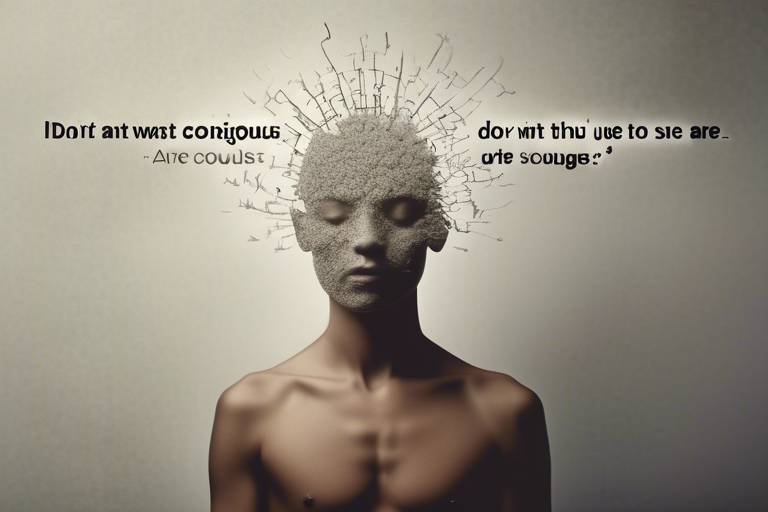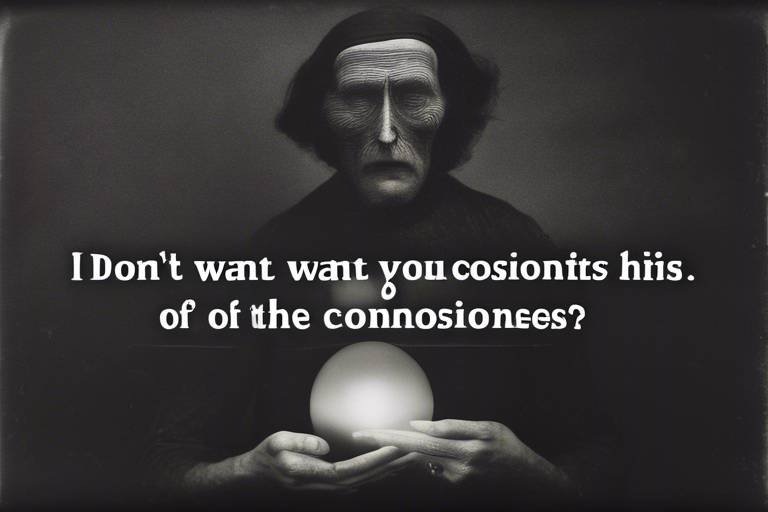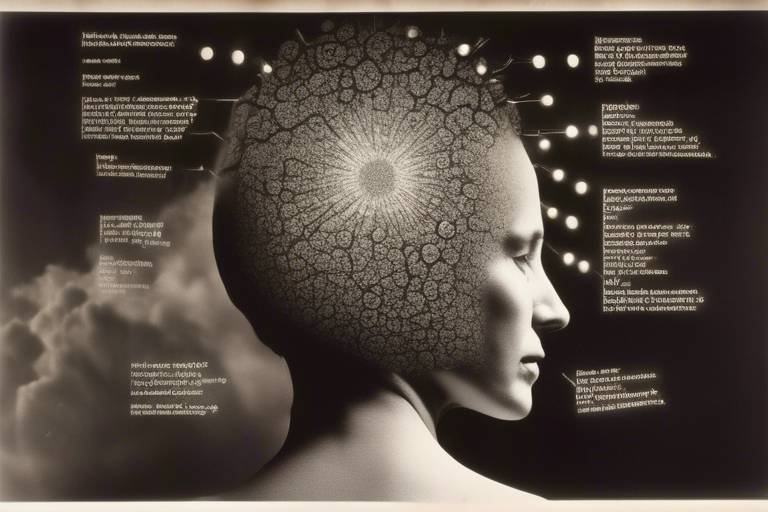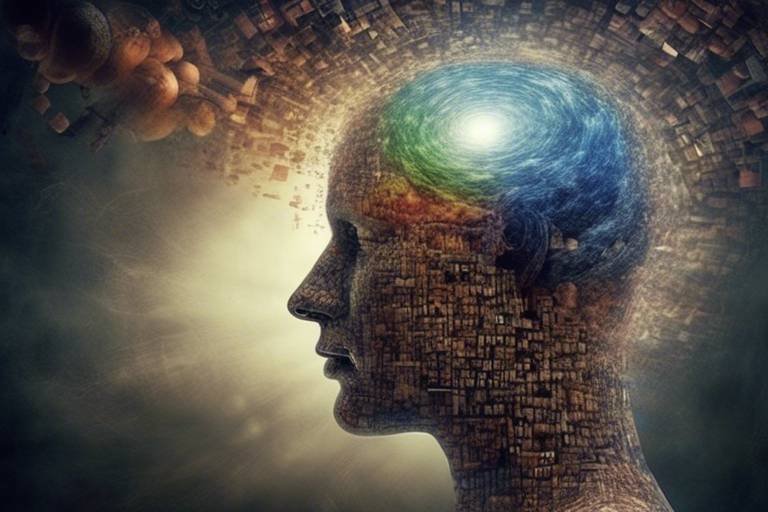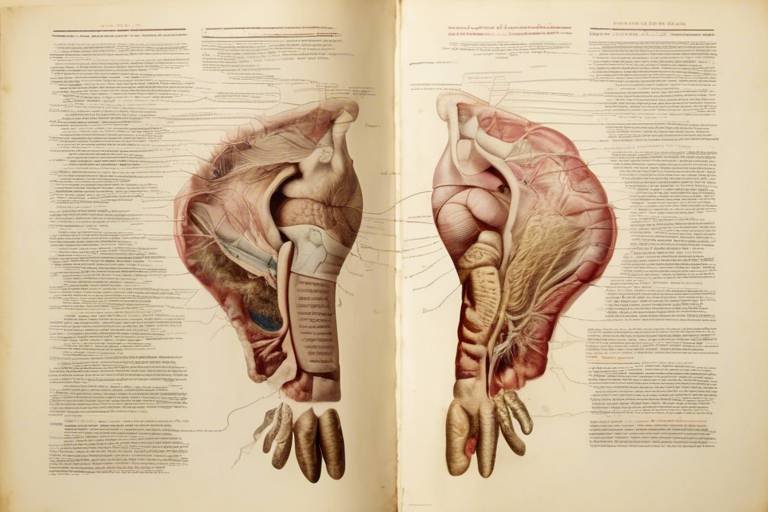Insights into the Altered States of Consciousness
Altered states of consciousness (ASCs) are fascinating realms of human experience that take us beyond the ordinary waking state. Think of them as mental landscapes where the usual rules of perception and cognition can bend, twist, and sometimes even break. Whether you're diving deep into meditation, dreaming vividly at night, or experiencing a trance-like state, these altered states offer unique insights into our minds and spirits. They can be like a rollercoaster ride through the psyche, filled with unexpected turns and exhilarating drops that reveal hidden aspects of our consciousness.
But what exactly are altered states of consciousness? In simple terms, they are any mental states that differ significantly from our normal waking consciousness. This can include everything from the deep relaxation of meditation to the vivid imagery of dreams or the focused attention of hypnosis. Each of these states brings its own flavor of experience, and understanding them can unlock a treasure trove of benefits for personal development, psychological healing, and spiritual growth.
As we delve deeper into the world of altered states, we uncover a variety of methods to induce these experiences. Practices such as meditation, sleep, and the use of psychoactive substances can all lead to profound shifts in consciousness. Imagine meditation as a key that unlocks hidden doors within your mind, allowing you to explore the vast, often uncharted territories of your inner self. This exploration can lead to remarkable insights and transformations, making the study of altered states not just an academic pursuit but a deeply personal journey.
In this article, we will explore the different types of altered states, their effects on the brain, and their significance in various fields such as psychology and spirituality. We will also look at how these altered states can be beneficial in therapeutic settings, helping individuals overcome challenges and achieve personal growth. So, buckle up as we embark on this enlightening journey through the altered states of consciousness!
Altered states of consciousness encompass a broad spectrum of mental states that can be induced through various practices. These states are not merely unusual; they represent a departure from our typical cognitive processes, allowing us to experience the world in new and often profound ways. For instance, during meditation, one may feel a sense of unity with the universe, while in a trance state, an individual might access memories or feelings that are usually buried deep within the subconscious.
Moreover, altered states can also be triggered by external factors such as sensory deprivation, rhythmic drumming, or even fasting. Each method can lead to different experiences, and understanding these nuances can help individuals choose the right path for their personal exploration. It's like picking the right tool for a job; the right method can make all the difference in achieving a desired state of consciousness.
There are several distinct types of altered states, each with its own characteristics and experiences. Some of the most notable include:
- Meditative States: Achieved through various forms of meditation, these states allow individuals to access deeper levels of awareness and relaxation.
- Hypnosis: A state of focused attention and heightened suggestibility, often used therapeutically.
- Trance States: These can occur naturally or be induced through rituals, music, or dance, leading to altered perceptions of reality.
- Dream States: The world of dreams offers a unique form of altered consciousness that can be both bizarre and enlightening.
Each of these states offers unique opportunities for exploration and growth, inviting individuals to tap into their subconscious and discover new aspects of themselves. The beauty of altered states lies in their diversity; they cater to different needs and experiences, making them a rich field for personal and spiritual development.
Meditation is one of the most widely practiced methods for inducing altered states of consciousness. When one engages in meditation, they often enter a profound state of relaxation and heightened awareness. This experience can be likened to diving into a calm sea, where the noise of the world above fades away, and you are left with the serene depths of your own mind. Within this space, individuals can access deeper levels of consciousness, leading to enhanced mental clarity and emotional balance.
Engaging in regular meditation has numerous benefits, including:
- Reduced Stress: Meditation helps to calm the mind and body, reducing stress levels significantly.
- Improved Focus: Regular practice enhances concentration and cognitive function.
- Increased Emotional Well-being: Meditation fosters a greater sense of peace and emotional stability.
These benefits contribute to a more fulfilling life and better mental health, making meditation a valuable practice for anyone looking to improve their overall well-being.
Various meditation techniques can help individuals achieve these altered states effectively and sustainably. Some popular methods include:
- Mindfulness Meditation: Focuses on being present and fully engaged with the moment.
- Guided Imagery: Uses visualization techniques to promote relaxation and insight.
- Transcendental Meditation: Involves the use of a mantra to settle the mind into a state of profound rest.
By exploring these techniques, individuals can find the approach that resonates most with them, paving the way for a richer meditative experience.
Hypnosis is another fascinating altered state characterized by focused attention and heightened suggestibility. Often used in therapeutic settings, hypnosis can help individuals address various issues, such as anxiety, phobias, and chronic pain. It's like having a conversation with your subconscious, where you can unlock the door to healing and transformation.
Altered states of consciousness can significantly affect brain activity, leading to changes in perception, cognition, and emotional processing. Understanding these effects can provide valuable insights into the workings of the human mind. For instance, during meditation, brain scans have shown increased activity in areas associated with emotional regulation and decreased activity in regions linked to stress response.
Recent neuroscientific studies have examined how different altered states influence brain function and connectivity. These findings shed light on the complexities of consciousness and how various practices can lead to profound changes in mental health and well-being. For example, research has indicated that meditation can enhance the brain's plasticity, allowing for improved cognitive flexibility and emotional resilience.
The therapeutic applications of altered states, such as guided imagery and hypnotherapy, are gaining recognition for their effectiveness in promoting healing and personal growth. These techniques can help individuals confront and process traumatic memories, reduce anxiety, and foster a greater sense of self-awareness. In many ways, they serve as powerful tools for transformation, enabling individuals to rewrite their narratives and embrace new possibilities.
1. What are altered states of consciousness?
Altered states of consciousness are mental states that differ from normal waking consciousness, often induced through practices like meditation, hypnosis, and sleep.
2. How can I achieve an altered state of consciousness?
You can achieve altered states through various methods, including meditation, hypnosis, sensory deprivation, and even certain psychoactive substances.
3. What are the benefits of altered states?
Benefits include reduced stress, improved emotional well-being, enhanced creativity, and greater self-awareness.
4. Is meditation the only way to experience altered states?
No, while meditation is a popular method, there are many ways to experience altered states, including hypnosis, trance, and dream states.
5. Can altered states be harmful?
While many altered states can be beneficial, it's essential to approach them with caution, especially when using substances or undergoing intense practices without proper guidance.

Understanding Altered States
Altered states of consciousness are fascinating realms of the human experience that diverge from our typical, waking awareness. Imagine stepping through a door that leads to a different version of reality, where your perceptions shift, and your thoughts take on new dimensions. These states can be induced through a variety of practices, including meditation, sleep, and the use of psychoactive substances. Each method provides a unique gateway to explore the depths of the mind, revealing insights that are often hidden in our everyday lives.
When we talk about altered states, we're referring to a spectrum of consciousness that can range from mild changes in awareness to profound experiences that can transform one’s perspective on life. For example, have you ever been so immersed in a book or a movie that you lost track of time? That’s a mild altered state! On the other hand, deep meditation or a psychedelic experience can catapult you into realms of existence that challenge your understanding of reality itself.
These states can be categorized into several types, each with its own characteristics and methods of induction. Here are some common types:
- Trance States: Often associated with deep relaxation and focused attention, leading to heightened suggestibility.
- Hypnosis: A therapeutic state used to access the subconscious mind, often employed to address various psychological issues.
- Dream States: Occurring during sleep, these states can be vivid and surreal, offering insights and reflections on waking life.
Understanding these altered states is not just for the curious; it has profound implications for fields such as psychology, spirituality, and personal development. For instance, many spiritual traditions emphasize the importance of meditation as a means to reach higher levels of consciousness. Similarly, psychologists explore these states to unlock the potential of the mind and address various mental health challenges. The interplay between these dimensions makes the study of altered states a rich and exciting area of exploration.
In conclusion, altered states of consciousness offer a unique lens through which we can examine the human experience. Whether through the calm of meditation, the deep relaxation of hypnosis, or the vivid realms of dreams, these states provide us with opportunities to expand our understanding of ourselves and the world around us. As we delve deeper into the science and practice of these altered states, we open ourselves to a greater appreciation of the complexities of consciousness.
- What are altered states of consciousness? Altered states of consciousness refer to mental states that differ from normal waking consciousness, often induced by meditation, sleep, or substances.
- How can I achieve an altered state? You can achieve altered states through practices like meditation, hypnosis, or engaging in deep relaxation techniques.
- Are altered states safe? While many altered states can be safe and beneficial, it's essential to approach them with caution and ideally under the guidance of a qualified professional.

Types of Altered States
When we delve into the intriguing world of altered states of consciousness, we uncover a rich tapestry of experiences that can radically shift our perception of reality. These states are not merely abstract concepts; they are tangible experiences that many individuals encounter throughout their lives. They can be triggered by a variety of methods, each leading to unique sensations and insights. Let’s explore some of the most common types of altered states, which include trance, hypnosis, and dream states.
First up, we have trance states. This is a fascinating state where an individual enters a focused form of awareness, often characterized by deep relaxation and a sense of detachment from the surrounding environment. Trance can be induced through repetitive stimuli, such as drumming or chanting, and is frequently utilized in various cultural rituals and practices. Imagine being so engrossed in a rhythm that the world around you fades away—that’s the beauty of trance!
Next, let’s talk about hypnosis, which is often misunderstood as mere entertainment. Hypnosis is a legitimate therapeutic tool that involves focused attention and heightened suggestibility. During hypnosis, individuals can access parts of their subconscious that are usually hidden, making it an effective method for addressing issues such as anxiety, phobias, and chronic pain. It’s like having a key to unlock a door in your mind that leads to profound insights and healing.
Then we have dream states, which occur during sleep. Dreams can be incredibly vivid and often feel more real than waking life. They can provide a window into our subconscious thoughts and emotions, revealing desires and fears we might not confront during our waking hours. Some people even practice lucid dreaming, where they become aware that they are dreaming and can manipulate the dream environment. This state can be both exhilarating and enlightening, offering a unique platform for personal exploration.
In addition to these primary types, there are other fascinating altered states worth mentioning, such as those induced by psychoactive substances. These substances can radically alter perception and consciousness, leading to experiences that can be both enlightening and disorienting. However, it’s crucial to approach this avenue with caution and respect, as the effects can vary widely based on individual physiology and mental state.
To summarize, the world of altered states is vast and varied, offering a myriad of experiences that can enhance our understanding of consciousness. Whether through trance, hypnosis, dreams, or even substances, these states provide a unique lens through which we can view ourselves and the world around us. Each type has its own characteristics, benefits, and potential risks, making it essential for individuals to approach them with curiosity and care.
- What are altered states of consciousness? Altered states of consciousness are mental states that differ from normal waking consciousness, often induced by various practices or substances.
- How can I safely explore altered states? It's important to approach altered states with caution. Techniques like meditation and guided imagery are safe practices to explore these states.
- Are altered states beneficial? Yes, many altered states can lead to enhanced self-awareness, emotional healing, and personal growth. However, individual experiences may vary.
- Can altered states be harmful? While many experiences are beneficial, some altered states, especially those induced by substances, can have adverse effects. It's essential to be informed and cautious.

Meditative States
Meditative states are fascinating realms of consciousness that many people seek to explore. When you think about meditation, you might picture someone sitting cross-legged, eyes closed, and completely still. But meditation is so much more than that! It’s a journey into the depths of your mind, a way to tap into a reservoir of calm and clarity that often feels just out of reach in our busy lives. By engaging in meditation, individuals can access profound levels of relaxation and heightened awareness, creating a space where the mind can truly thrive.
During meditation, the brain undergoes remarkable changes. Studies have shown that it can shift from a state of high beta waves—often associated with stress and anxiety—to more tranquil alpha and theta waves. This transition allows for a deeper connection to oneself, promoting a sense of peace and well-being. Imagine your mind as a bustling city during rush hour, filled with noise and chaos. Now, picture that city quieting down, the streets emptying, and the buildings shimmering in the soft glow of twilight. That’s what meditative states can feel like—a serene escape from the hustle and bustle of everyday life.
One of the most appealing aspects of meditation is its accessibility. You don’t need to be a seasoned yogi or spend hours in silence to reap its benefits. In fact, just a few minutes of focused breathing can shift your mental state dramatically. Here are some common techniques that can help you dive into meditative states:
- Mindfulness Meditation: This involves paying attention to the present moment without judgment. It’s about observing your thoughts and feelings as they arise and letting them pass without getting caught up in them.
- Guided Imagery: In this technique, a guide leads you through a visualization that can evoke relaxation and healing. It’s like taking a mental vacation!
- Transcendental Meditation: This practice involves silently repeating a specific mantra to settle the mind into a state of profound rest.
Each of these techniques offers a unique pathway into a meditative state, allowing individuals to find the approach that resonates most with them. Whether you’re looking to reduce stress, enhance focus, or simply find a moment of peace in your day, meditation can be a powerful tool. It’s like having a personal oasis that you can access anytime, anywhere.
The benefits of meditation extend beyond just the immediate sense of calm. Research indicates that regular meditation practice can lead to long-term improvements in mental health, emotional regulation, and overall quality of life. It’s not just about feeling good in the moment; it’s about cultivating a resilient mind that can navigate life’s challenges with grace and ease. So, why not give it a try? You might just find that meditative states open up a whole new world of possibilities for your mind and spirit.
- What is the best time to meditate? While the best time varies for everyone, many find that early morning or late evening works best for establishing a routine.
- How long should I meditate? Even a few minutes can be beneficial. Aim for at least 5-10 minutes daily, gradually increasing as you become more comfortable.
- Do I need to sit cross-legged to meditate? Not at all! You can meditate in any comfortable position, whether sitting in a chair, lying down, or even walking.

Benefits of Meditation
This article explores the various dimensions of altered states of consciousness, including their definitions, types, effects, and significance in psychology, spirituality, and personal development.
Altered states of consciousness encompass various mental states that differ from normal waking consciousness. They can be induced through various practices, such as meditation, sleep, and the use of psychoactive substances.
There are several types of altered states, including trance, hypnosis, and dream states. Each type has unique characteristics and can be experienced through different methods and practices.
Meditation induces a profound state of relaxation and awareness, allowing individuals to access deeper levels of consciousness. This practice can lead to enhanced mental clarity and emotional balance.
Engaging in meditation has numerous benefits that can transform your life in ways you might not even expect. Imagine starting your day with a clear mind and a sense of calm; that’s just one of the gifts meditation offers. Here are some of the remarkable benefits:
- Reduced Stress: One of the most immediate effects of meditation is its ability to lower stress levels. By focusing on the present moment, you can let go of worries and anxieties that cloud your mind.
- Improved Focus: Regular meditation practice sharpens your concentration. It’s like training your brain to hit the bullseye every time, enhancing your productivity in daily tasks.
- Increased Emotional Well-being: Meditation fosters a deeper understanding of your emotions. This can lead to better emotional regulation, allowing you to respond to life’s challenges with grace and composure.
- Enhanced Self-awareness: Through meditation, you can gain insights into your thoughts and behaviors, paving the way for personal growth and transformation.
These benefits contribute to a more fulfilling life and better mental health. Just think of meditation as a mental workout; the more you practice, the stronger your "mental muscles" become!
Various meditation techniques, such as mindfulness, guided imagery, and transcendental meditation, can help individuals achieve altered states of consciousness effectively and sustainably. Each technique offers a unique pathway to inner peace and clarity, making it essential to find the one that resonates with you.
Hypnosis is a state of focused attention and heightened suggestibility. It can be used therapeutically to address various issues, such as anxiety, phobias, and chronic pain.
Altered states can significantly affect brain activity, leading to changes in perception, cognition, and emotional processing. Understanding these effects can provide insights into the workings of the human mind.
Recent neuroscientific studies have examined how different altered states influence brain function and connectivity. These findings offer valuable insights into consciousness and its complexities.
Therapeutic applications of altered states, such as guided imagery and hypnotherapy, are gaining recognition for their effectiveness in promoting healing and personal growth.
Q: How long should I meditate each day to see benefits?
A: Even a short daily practice of 10-15 minutes can yield significant benefits. Consistency is key!
Q: Can anyone learn to meditate?
A: Absolutely! Meditation is accessible to everyone, regardless of experience. Just find a method that suits you.
Q: What if my mind wanders during meditation?
A: It's completely normal! Acknowledge the thoughts and gently bring your focus back to your breath or mantra.
Q: Are there any risks associated with meditation?
A: While meditation is generally safe, some individuals may experience discomfort or anxiety. It’s important to approach it with patience.

Techniques for Meditation
Meditation is a transformative practice that can lead to profound changes in your mental and emotional state. But how do you get started? There are various that cater to different preferences and lifestyles, making it accessible to everyone. Whether you're a beginner or a seasoned practitioner, finding the right technique can enhance your experience and deepen your practice.
One of the most popular methods is mindfulness meditation. This technique encourages you to focus on the present moment, observing your thoughts and feelings without judgment. Imagine sitting quietly, allowing your mind to drift like clouds across a vast sky. You acknowledge each thought as it passes but don’t hold onto it. This practice can significantly reduce stress and anxiety, creating a sense of peace in your daily life.
Another effective method is guided imagery. In this technique, you visualize a serene environment, such as a tranquil beach or a peaceful forest. As you immerse yourself in this mental landscape, you can feel the sensations and emotions associated with it. This form of meditation is particularly beneficial for those who find it challenging to quiet their minds, as it provides a tangible focus.
Transcendental Meditation (TM) is also widely recognized. In TM, practitioners silently repeat a specific mantra, which helps them transcend ordinary thought and reach a state of profound rest. This technique is unique because it’s often taught through certified instructors, ensuring that individuals receive personalized guidance. Many practitioners report that TM leads to increased creativity and a deeper sense of inner peace.
For those who enjoy a more active approach, movement-based meditation techniques, such as yoga or tai chi, can be incredibly beneficial. These practices combine physical movement with breath awareness, allowing you to meditate through motion. It’s akin to dancing your way into a state of mindfulness, where each movement becomes a form of meditation in itself.
Regardless of the technique you choose, consistency is key. Establishing a regular practice can help you experience the full benefits of meditation. Consider creating a schedule that fits your lifestyle, whether it’s a few minutes in the morning or a longer session in the evening. You might even want to track your progress in a journal to see how your practice evolves over time.
In conclusion, the world of meditation is rich with techniques that can cater to your unique needs and preferences. Experimenting with different methods can help you discover what resonates most with you, ultimately leading to a more fulfilling and transformative experience.
- What is the best time to meditate? While any time can be beneficial, many people find that meditating in the morning sets a positive tone for the day.
- How long should I meditate? Starting with just 5-10 minutes a day can be effective, gradually increasing the duration as you become more comfortable.
- Do I need to sit cross-legged to meditate? Not at all! You can meditate sitting in a chair, lying down, or even walking—whatever feels comfortable for you.
- Can I listen to music while meditating? Yes! Soft, calming music or nature sounds can enhance your meditation experience, but it’s essential to choose something that doesn’t distract you.

Hypnosis and Trance
Hypnosis is a fascinating state of consciousness characterized by focused attention, heightened suggestibility, and deep relaxation. Imagine it as a mental highway where the usual traffic of thoughts slows down, allowing you to navigate through your mind with ease. In this state, individuals can access memories and emotions that may be buried deep within their subconscious, making it a powerful tool for personal growth and healing. But what exactly happens when someone is hypnotized? Well, during hypnosis, the brain enters a unique rhythm, often transitioning into a theta state, where creativity and intuition flourish.
Trance, on the other hand, is a broader term that encompasses various altered states of consciousness, including hypnosis. Think of trance as a spectrum, with hypnosis being one of its many colors. People can enter trance states through various methods such as meditation, rhythmic drumming, or even dancing. Each of these practices can induce a trance-like state that allows for a shift in perception and awareness. The beauty of trance lies in its versatility; it can be a spontaneous experience or a deliberate practice, opening doors to creativity, self-discovery, and profound insights.
Both hypnosis and trance have been used for centuries in different cultures for healing and spiritual purposes. In ancient times, shamans would enter trance states to connect with the spiritual realm, seeking guidance and healing for their communities. Today, modern psychology has embraced these practices, recognizing their therapeutic potential. Hypnotherapy, for instance, is increasingly being used to help individuals overcome challenges such as anxiety, phobias, and chronic pain. By tapping into the subconscious mind, hypnotherapists can facilitate positive changes in behavior and thought patterns.
One of the remarkable aspects of hypnosis is its ability to create a state of deep relaxation, which can have profound effects on both the mind and body. When individuals are in a hypnotic state, their bodies can enter a state of rest that is often deeper than sleep. This can lead to numerous benefits, including:
- Stress Reduction: Hypnosis can help lower cortisol levels, promoting relaxation and reducing stress.
- Pain Management: Many people report significant relief from chronic pain conditions through hypnotherapy.
- Enhanced Focus: The focused attention in hypnosis can improve concentration and mental clarity.
In summary, hypnosis and trance are powerful tools that can lead to transformative experiences. Whether used for therapeutic purposes or personal exploration, these altered states of consciousness offer a pathway to deeper understanding and healing. As we continue to explore the intricacies of the mind, the potential of hypnosis and trance remains an exciting frontier in the realms of psychology and spirituality.
What is the difference between hypnosis and trance?
Hypnosis is a specific state of focused attention and heightened suggestibility, while trance is a broader term that includes various altered states of consciousness.
Can anyone be hypnotized?
Yes, most people can be hypnotized to some degree, but the depth of hypnosis can vary from person to person.
Is hypnosis safe?
Yes, hypnosis is generally considered safe when practiced by trained professionals. It is a natural state of consciousness and does not involve any harmful substances.
How can I use hypnosis for personal development?
Hypnosis can be used to address various personal challenges, such as overcoming fears, improving self-esteem, and enhancing motivation. Working with a qualified hypnotherapist can help you achieve your goals.

Effects on the Brain
Altered states of consciousness are not just fascinating experiences; they have profound effects on the brain that can reshape our understanding of perception, cognition, and emotional processing. When individuals enter these states, whether through meditation, hypnosis, or other means, their brains undergo significant changes that can be measured and analyzed. This transformation can lead to a variety of outcomes, influencing everything from how we feel to how we think.
One of the most intriguing aspects of altered states is their ability to change brain activity patterns. For instance, during meditation, studies have shown that there is an increase in alpha and theta brain wave activity, which are associated with relaxation and creativity. This shift can result in a sense of calm and a heightened state of awareness, allowing individuals to tap into deeper levels of consciousness. In contrast, during states of heightened stress or anxiety, the brain often shows increased activity in the amygdala, the area responsible for processing emotions, particularly fear.
Moreover, altered states can also enhance connectivity between different regions of the brain. Research indicates that during meditation, there is improved communication between the prefrontal cortex, which governs decision-making and self-regulation, and the limbic system, which is responsible for emotions. This enhanced connectivity can lead to better emotional regulation and an increased ability to cope with stress. Imagine your brain as a bustling city; when traffic flows smoothly between neighborhoods, everything runs more efficiently, leading to a more harmonious experience.
To illustrate the effects of altered states on brain function, consider the following table that summarizes key findings from neuroscientific research:
| Altered State | Brain Activity Changes | Effects |
|---|---|---|
| Meditation | Increased alpha and theta waves | Enhanced relaxation, improved focus |
| Hypnosis | Altered connectivity between brain regions | Heightened suggestibility, pain relief |
| Dream States | Increased activity in the visual cortex | Vivid imagery, emotional processing |
Understanding the effects of altered states on the brain is not just an academic exercise; it has practical implications for therapy and personal development. For example, therapists are increasingly utilizing techniques that induce altered states, such as guided imagery and hypnotherapy, to help clients overcome challenges like anxiety and chronic pain. These therapeutic applications leverage the brain's plasticity, allowing individuals to rewire their thought patterns and emotional responses.
In conclusion, the exploration of altered states of consciousness opens a window into the complexities of the human mind. By studying how these states affect brain activity, we can gain valuable insights into improving mental health and enhancing personal growth. The brain is a remarkable organ, capable of profound change, and understanding its workings can empower us to explore the depths of our consciousness.
- What are altered states of consciousness? Altered states of consciousness refer to mental states that differ from normal waking consciousness, often induced by meditation, hypnosis, or psychoactive substances.
- How does meditation affect the brain? Meditation can increase alpha and theta brain waves, enhancing relaxation and focus while improving emotional regulation through better connectivity between brain regions.
- Can altered states be used therapeutically? Yes, altered states are used in therapeutic practices like hypnotherapy and guided imagery to address issues such as anxiety, phobias, and chronic pain.

Neuroscientific Research
This article explores the various dimensions of altered states of consciousness, including their definitions, types, effects, and significance in psychology, spirituality, and personal development.
Altered states of consciousness encompass various mental states that differ from normal waking consciousness. They can be induced through various practices, such as meditation, sleep, and the use of psychoactive substances.
There are several types of altered states, including trance, hypnosis, and dream states. Each type has unique characteristics and can be experienced through different methods and practices.
Meditation induces a profound state of relaxation and awareness, allowing individuals to access deeper levels of consciousness. This practice can lead to enhanced mental clarity and emotional balance.
Engaging in meditation has numerous benefits, including reduced stress, improved focus, and increased emotional well-being. These benefits contribute to a more fulfilling life and better mental health.
Various meditation techniques, such as mindfulness, guided imagery, and transcendental meditation, can help individuals achieve altered states of consciousness effectively and sustainably.
Hypnosis is a state of focused attention and heightened suggestibility. It can be used therapeutically to address various issues, such as anxiety, phobias, and chronic pain.
Altered states can significantly affect brain activity, leading to changes in perception, cognition, and emotional processing. Understanding these effects can provide insights into the workings of the human mind.
Recent neuroscientific studies have examined how different altered states influence brain function and connectivity. These findings offer valuable insights into consciousness and its complexities. For instance, neuroimaging techniques such as fMRI and EEG have been employed to observe changes in brain activity during various altered states. Researchers have discovered that:
- Meditation can lead to increased activity in the prefrontal cortex, which is associated with higher-order thinking and emotional regulation.
- Hypnosis has been shown to decrease activity in the default mode network (DMN), a network of brain regions that is active when the mind is at rest and not focused on the external environment. This reduction may explain the heightened focus and suggestibility often experienced during hypnosis.
- Lucid dreaming presents a fascinating case where brain activity resembles both waking and REM sleep states, highlighting the complexities of consciousness.
Moreover, studies indicate that engaging in these altered states can result in structural changes in the brain over time, such as increased gray matter density in regions associated with emotional regulation and self-awareness. This suggests that the practice of meditation or hypnosis not only influences our immediate mental state but can also lead to long-term improvements in mental health and cognitive function.
As research continues to evolve, it opens up exciting possibilities for therapeutic applications. For instance, understanding how these states affect brain connectivity can lead to more effective treatments for mental health disorders, enhancing the efficacy of therapies like cognitive behavioral therapy (CBT) and mindfulness-based stress reduction (MBSR).
Therapeutic applications of altered states, such as guided imagery and hypnotherapy, are gaining recognition for their effectiveness in promoting healing and personal growth.
- What are altered states of consciousness? Altered states of consciousness are mental states that differ from normal waking consciousness, often induced through meditation, hypnosis, or psychoactive substances.
- How can I achieve an altered state? You can achieve altered states through various practices, including meditation, deep breathing exercises, and hypnosis.
- Are altered states safe? Yes, when practiced responsibly and under guidance, altered states can be safe and beneficial for mental health and personal development.

Applications in Therapy
When it comes to the therapeutic applications of altered states of consciousness, the possibilities are as vast as the human experience itself. These states can serve as powerful tools in the hands of trained professionals, facilitating healing and personal transformation. One of the most recognized methods is hypnotherapy, where clients are guided into a trance-like state to explore their subconscious. This process can help address a myriad of issues, from anxiety and depression to chronic pain and addictions. By tapping into the deeper layers of the mind, hypnotherapists can help clients uncover the root causes of their problems, leading to lasting change.
Another fascinating application is through guided imagery, a technique that employs the imagination to evoke positive mental images, sensations, and feelings. This practice can be particularly beneficial for individuals undergoing stress or dealing with traumatic experiences. By immersing themselves in a mental landscape crafted by a therapist, clients can foster a sense of peace and well-being. It’s like taking a mini-vacation in your mind, where you have the power to create your ideal sanctuary, free from the burdens of everyday life.
Moreover, the integration of mindfulness meditation into therapeutic settings has gained traction. Mindfulness encourages individuals to stay present and aware, which can be transformative for those struggling with overwhelming emotions or racing thoughts. Therapists often guide clients in mindfulness practices, helping them to cultivate a deeper awareness of their thoughts and feelings. This can lead to improved emotional regulation and a greater sense of control over one's mental state, almost like having a remote control for your mind.
To further illustrate the impact of these techniques, consider the following table that summarizes some key applications of altered states in therapy:
| Technique | Application | Benefits |
|---|---|---|
| Hypnotherapy | Addressing anxiety, phobias, and chronic pain | Access to subconscious, lasting change |
| Guided Imagery | Stress reduction, trauma recovery | Enhanced relaxation, emotional healing |
| Mindfulness Meditation | Emotional regulation, focus improvement | Increased awareness, better control |
As we delve deeper into the realm of therapeutic applications, it becomes evident that altered states of consciousness are not merely abstract concepts; they are practical tools that can foster profound change. Whether it’s through hypnotherapy, guided imagery, or mindfulness, these techniques offer pathways to healing that resonate with individuals on a personal level. They empower people to confront their challenges, rediscover their strengths, and cultivate a more fulfilling life. After all, who wouldn’t want to unlock the hidden potential of their mind?
- What is hypnotherapy? Hypnotherapy is a therapeutic technique that uses guided relaxation and focused attention to achieve a heightened state of awareness, often to address psychological issues.
- Can anyone be hypnotized? Most individuals can be hypnotized, but susceptibility varies. It often depends on the person's willingness and openness to the process.
- How does guided imagery work? Guided imagery involves visualizing calming and positive images to promote relaxation and emotional healing, often led by a therapist.
- Is mindfulness meditation effective? Yes, mindfulness meditation has been shown to reduce stress, improve emotional regulation, and enhance overall well-being.
Frequently Asked Questions
- What are altered states of consciousness?
Altered states of consciousness refer to mental states that differ from normal waking consciousness. They can be induced through practices like meditation, sleep, or the use of psychoactive substances. Think of it as stepping through a door into a different room of your mind, where perceptions and experiences can shift dramatically.
- What types of altered states exist?
There are several types of altered states, including trance, hypnosis, and dream states. Each type has its unique characteristics and can be experienced through different methods. For example, meditation can lead to a serene state of awareness, while hypnosis might put you in a state of focused attention.
- How does meditation induce altered states?
Meditation helps to quiet the mind and brings about deep relaxation and heightened awareness. When you meditate, you might feel like you’re floating or deeply connected to your surroundings. This profound state allows you to access deeper levels of consciousness, leading to insights and emotional balance.
- What are the benefits of meditation?
Engaging in meditation offers numerous benefits, such as reduced stress, improved focus, and enhanced emotional well-being. Imagine it like hitting the reset button on your mind, allowing you to approach life with renewed energy and perspective.
- What techniques can I use for meditation?
There are various meditation techniques, including mindfulness, guided imagery, and transcendental meditation. Each technique serves as a different pathway to achieving those altered states of consciousness. It's all about finding the route that resonates with you the most!
- What is hypnosis and how does it work?
Hypnosis is a state of focused attention and heightened suggestibility, often used therapeutically. It can help address issues like anxiety, phobias, and chronic pain by allowing the individual to tap into their subconscious. Think of it as a mental highway that lets you bypass the usual traffic jams of your thoughts.
- How do altered states affect the brain?
Altered states can significantly change brain activity, leading to shifts in perception, cognition, and emotional processing. Understanding these effects can provide insights into how our minds work, much like peering under the hood of a car to see what makes it run.
- What does neuroscientific research say about altered states?
Recent studies in neuroscience have explored how different altered states influence brain function and connectivity. These findings shed light on the complexities of consciousness, much like mapping out the intricate pathways in a sprawling city.
- How are altered states used in therapy?
Therapeutic applications of altered states, such as guided imagery and hypnotherapy, are becoming increasingly recognized for their effectiveness in promoting healing and personal growth. They can serve as powerful tools for unlocking potential and addressing mental health challenges.


